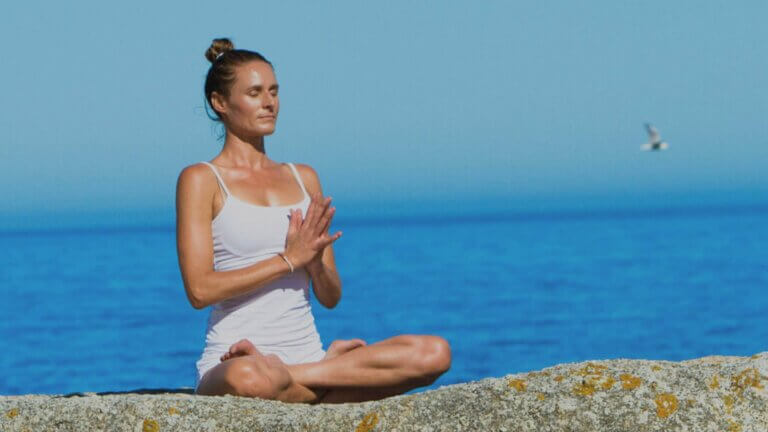Home » Yoga Blog » Beginner Yoga Blog » What do you call a Person that Practices Yoga?
What do you call a Person that Practices Yoga?
Definition and Origin of Yoga
What do you call someone who practices yoga? To begin we must understand that Yoga is an ancient practice rooted in Indian philosophy. It is derived from the Sanskrit word “Yuj,” meaning to join or unite, symbolizing the union of body and consciousness. From Yogi to Yogi and Sadhu to Sadhu, this practice has evolved over thousands of years. In the process of creating historical texts pivotal to yoga’s development:
- Rig Veda is one of the oldest sacred texts.
- Bhagavad Gita – a 700-verse Hindu scripture.
- Yoga Sutras of Patanjali is a foundational text of yoga philosophy.
These texts document yoga’s evolution and encapsulate its spiritual and philosophical depth.
In this Yoga Blog Post
- Who Practices Yoga?
- The Increasing Popularity of Yoga
- The Practice and Types of Yoga
- Yoga Poses and Postures
- Beyond Physicality: Yoga as a Mental and Spiritual Practice
- Health Benefits and Yoga Practice as Therapy
- The Yoga Community and Cultural Perspectives
Who Practices Yoga? The Yoga Practitioner or Yogi
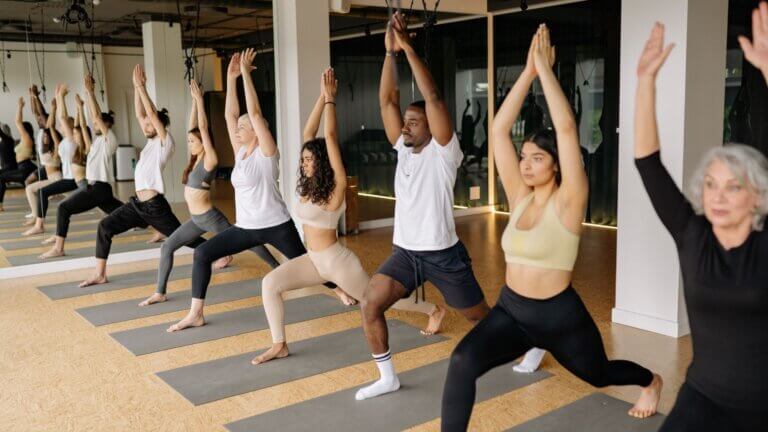
A yoga practitioner, or often we call a person a yogi, is someone that engages in the yoga practice. The beauty of yoga lies in its accessibility and adaptability, welcoming individuals from all walks of life. This inclusivity means:
- People of all ages can practice yoga.
- Yoga is suitable for various fitness levels, from beginners to advanced practitioners.
Yoga transcends physical exercise, encompassing mental and spiritual growth as well.
The Increasing Popularity of Yoga
In recent years, yoga has seen a surge in popularity globally, particularly in Western culture. This growth is evident through:
- An increase in the number of in-person and online yoga studios and classes.
- Greater visibility in media and online platforms.
- Growing adoption into Workplace Wellness Programs
Research and studies, such as those conducted by the American College of Physicians, have significantly validated yoga’s health benefits, further fueling its popularity.
The Practice and Types of Yoga
Different Styles and Types of Yoga Practices
Yoga manifests in various styles, each offering a Yogi unique benefits and experiences. Key types include:
- Hatha Yoga: A foundational style focusing on physical postures and breath control, ideal for beginners.
- Kundalini Yoga: This practice focuses on awakening energy at the spine’s base, combining poses, breathing techniques, and meditation.
- Bhakti Yoga: Centers around love and devotion, often involving chanting and singing.
- Karma Yoga: The yoga of action, focusing on selfless service and fulfilling duties.
- Vinyasa Yoga: This practice features flowing movements synchronized with breath, typically more dynamic.
- Ashtanga Yoga: A rigorous style characterized by a specific sequence of poses practiced in a precise order, promoting strength and discipline. It is famous for its advanced pretzel-like contortion poses. Often we call the people who practice this form of yoga Ashtangis
- Iyengar Yoga: Known for its emphasis on precision and alignment in executing postures, often using props like blocks and straps.
- Traditional Tantra Yoga: An ancient practice focusing on expanding consciousness and spiritual growth, integrating rituals, meditation, and breathwork.
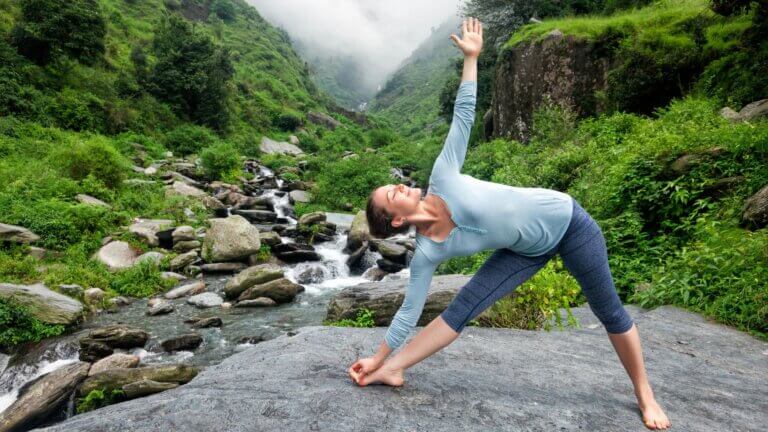
Modern yoga Adaptations for Contemporary Lifestyles
The evolving practice of yoga has led to the creation of modern yoga styles. Yoga styles that cater to today’s diverse yogi preferences and needs. These include:
- Hot Yoga or Bikram Yoga: This style enhances flexibility and promotes detoxification in a heated room.
- Gentle Yoga: A softer, more relaxed form of yoga, ideal for stress relief and relaxation.
- Yoga Nidra: Often referred to as “yogic sleep,” this guided meditation induces deep relaxation and mental clarity.
- Yin Yoga: A slow-paced style where poses are held for extended periods, targeting deep connective tissues, improving flexibility, and promoting inner stillness. Often we call the people who practice this form of yoga Yinsters.
- Aerial Yoga: Combines traditional yoga with moves performed on a hammock-like apparatus, adding an element of playfulness and new challenges.
- Acro Yoga: A physical practice that combines yoga and acrobatics, emphasizing partner work for building strength and trust.
- Power Yoga: A fitness-based approach, this style is vigorous and athletic, focusing on strength and flexibility.
- Restorative Yoga: This gentle, healing form of yoga where poses are held for extended periods, often supported by props, to encourage deep relaxation and rejuvenation.
- Rocket Yoga: This practice is a more “accessible” Ashtanga Yoga. It allows for a fluid movement from one pose to another, encouraging evenness of breath and a dynamic style of body movement.
- Kemetic Yoga: A contemporary take on an ancient form of Egyptian Yoga, Smai Tawi. Drawing from deep roots in Egyptian spiritual practices, you can find the history of Kemetic Yoga in wall carvings and hieroglyphic texts within ancient temples.
These modern adaptations demonstrate yoga’s versatility and ability to integrate into various aspects of contemporary life, offering something for everyone, whether they seek relaxation, physical challenge, or playful exploration.
Yoga Poses and Postures
At the core of many yoga practices are asanas (yoga postures). Key aspects include:
- Common poses and kriyas are sun salutations (Surya Namaskar), Sphinx Pose (Salamba Bhujangasana), downward-facing dog (Adho Mukha Svanasana), and Butterfly (Baddha Konasana)
- The importance of asanas lies in their ability to strengthen and align the body and breath, improve flexibility, and aid in concentration and mindfulness.
Physical postures in yoga are more than just exercises; they are tools for a yogi personal growth and self-awareness.
Beyond Physicality: Yoga as a Mental and Spiritual Practice
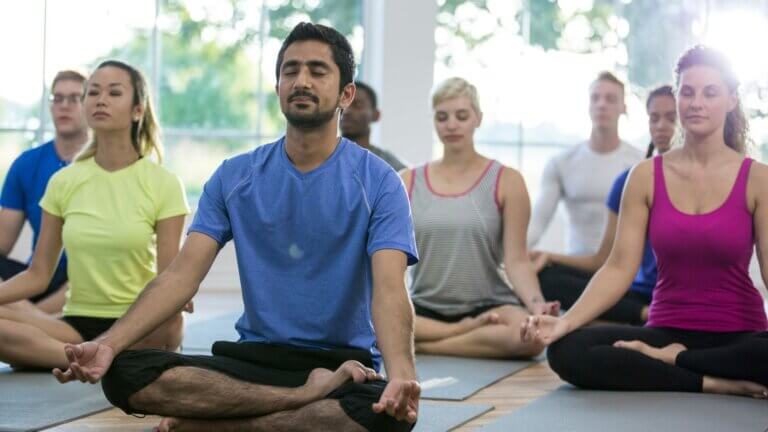
Yoga transcends physical exercise and is deeply rooted in spirituality and mental well-being:
- The spiritual aspects of yoga involve self-reflection, connection to a higher purpose, and understanding the deeper aspects of existence.
- On the mental health front, yoga is known for its benefits in stress management and enhancing mental clarity.
This holistic approach to wellness makes yoga a profound practice for many. A practice offering the yogi a path to physical fitness, inner peace, and mental resilience.
Health Benefits and Yoga Practice as Therapy
Physical and Mental Health Benefits
Yoga offers various health benefits, addressing both physical and mental wellness.
Physical Health:
- Chronic Pain: Yoga can alleviate discomfort associated with chronic conditions.
- Lower Back Pain: Gentle yoga poses can strengthen back muscles and improve posture.
- Shoulder and Neck Pain: Improved mobility and relief through targeted Movements and stretches
- High Blood Pressure: Regular practice helps in managing blood pressure levels.
- Weight Loss: Certain yoga styles can aid in weight management and overall fitness.
Mental Health:
- Yoga is highly effective in treating anxiety disorders and reducing symptoms of stress.
- Practices like meditation and mindfulness in yoga contribute to improved mental clarity and focus.
- Yoga employs relaxation techniques such as deep breathing, which are beneficial in calming the mind and reducing stress.
The versatility of yoga in addressing a wide range of health issues makes it a popular choice for those seeking holistic well-being.
Yoga Practice as a Form of Therapy
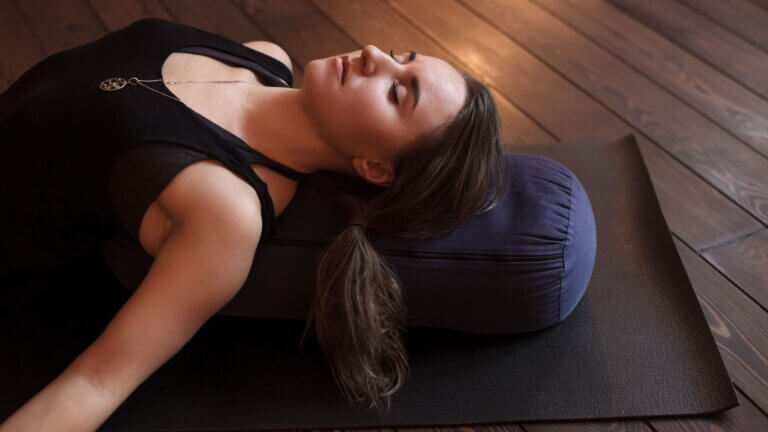
Yoga’s therapeutic application is increasingly recognized, with dedicated professionals and programs focusing on its healing potential:
Certified Yoga Therapist:
- These professionals undergo specialized training to use yoga as a therapeutic tool. They tailor a yoga therapy session to individual needs, addressing specific health conditions and goals.
Yoga Therapy Programs:
- Offered by various institutions, the program’s design is to treat health conditions holistically.
- They combine physical postures, breathing exercises, and meditation to promote overall health and well-being.
Research and Recognition:
- Recent Studies by organizations like the National Center for Complementary and Integrative Health have shown yoga’s effectiveness in managing conditions such as anxiety, depression, and chronic pain.
- Healthcare professionals increasingly recommend yoga therapy as a complementary treatment.
Yoga therapy’s growing acceptance in the medical community highlights its potential as a practical and natural approach to health and healing.
The Yoga Community and Cultural Perspectives
Yoga Classes and Community
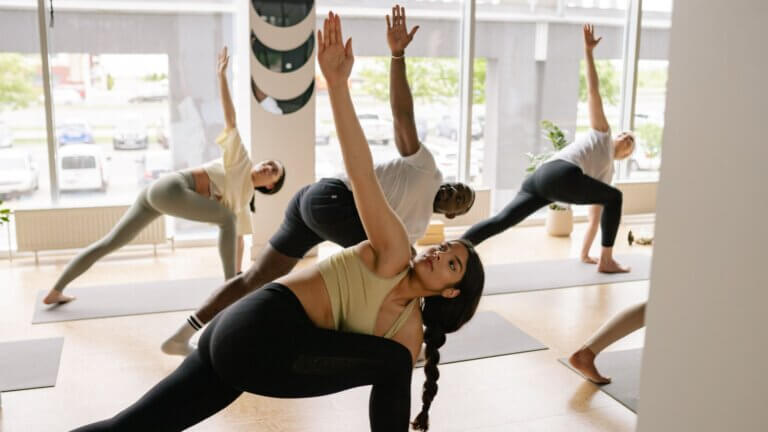
The role of yoga studios and fitness centers extends beyond mere online or physical spaces for exercise; they are pivotal in nurturing the yoga community:
Yoga Studios and Fitness Centers:
- These venues serve as the heart of the yoga community, offering a welcoming environment for practitioners of all levels.
- They encourage communal learning, the sharing of experiences, and the formation of supportive networks.
Certified Yoga Instructors:
- The quality of instruction is paramount in yoga. A certified yoga instructor not only imparts knowledge about physical poses but also integrates the philosophy and ethics of yoga into their teaching.
- Characteristics of a good yoga teacher include empathy, patience, a deep understanding of yoga’s diverse aspects, and the ability to adapt to individual student needs.
- Instructors play a crucial role in ensuring safe practice, fostering personal growth, and maintaining the integrity of yoga traditions.
- Some cultures and practice call their Yoga Teachers Gurus
The yoga community, bolstered by dedicated spaces and knowledgeable teachers, forms a nurturing ecosystem that supports personal and collective well-being.
Cultural and Ethical Aspects
As yoga transcends its traditional boundaries, it encounters cultural and ethical nuances.
Cultural Appropriation in Yoga:
- The global spread of yoga has led to concerns about cultural appropriation. Sometimes, yoga in Western societies detaches from its rich, spiritual lineage, leading to a superficial or commodified representation.
- This phenomenon raises crucial questions about respecting the cultural and spiritual origins of yoga and the responsibility of practitioners and teachers to honor its heritage.
Yoga and Spiritual Teachings:
- Integral to yoga’s essence are its roots in spiritual teachings, deeply embedded in Hindu and Buddhist traditions.
- Yoga transcends religious boundaries, drawing parallels with spiritual figures like Jesus Christ and paying homage to the concept of the first guru and spiritual teacher. This homage showcases yoga’s ability to embrace and respect various spiritual beliefs.
- Such references in yoga underscore its all-encompassing nature, promoting understanding and respect for many spiritual paths.
In navigating these cultural and ethical aspects, practitioners and teachers are called upon to approach yoga with mindfulness and respect, ensuring its integrity as a holistic practice.
Further Pathways for a person who practices yoga
Summarizing the Yoga Practitioner's Journey
In exploring the world of yoga and what we call the people that practice we have uncovered various facets:
- Types of Yoga: We delved into Hatha, Kundalini, Bhakti, Karma, and Vinyasa Yoga, along with modern adaptations like hot yoga and yoga nidra.
- Health Benefits: Highlighting Yoga’s role in alleviating chronic pain, lower back pain, high blood pressure, and anxiety disorders. Discussion on Its positive impact on mental health and relaxation techniques.
- Yoga Community: Emphasizing the significance of yoga studios, fitness centers, and the role of a certified yoga instructor in building a supportive yoga community.
A consistent theme is the importance of regular practice and daily routines in deepening one’s yoga journey, emphasizing that yoga is more than just an exercise; it’s a way of life.
Yoga Practice in Everyday Life and Future Outlook
Yoga transcends physical practice and we we call the people. Yoga impacts various aspects of daily life and personal development:
Life Skills and Self-Care: Regular yoga practice cultivates essential life skills such as discipline, patience, and mindfulness. It promotes better self-care and an introspective lifestyle, encouraging practitioners to live more consciously and harmoniously.
Yoga’s Future in Society:
- The role of yoga in contemporary society is ever-evolving. It’s integrating into various sectors, including healthcare, education, and corporate wellness.
- The future of yoga intertwines more deeply with fitness trends and spiritual exploration, indicating a growing recognition of its holistic benefits.
Yoga’s journey from an ancient practice to a modern-day wellness solution demonstrates its timeless relevance and adaptability. As it continues to evolve, it promises to enrich lives, foster communities, and guide individuals (or yogis) toward physical, mental, and spiritual well-being.


